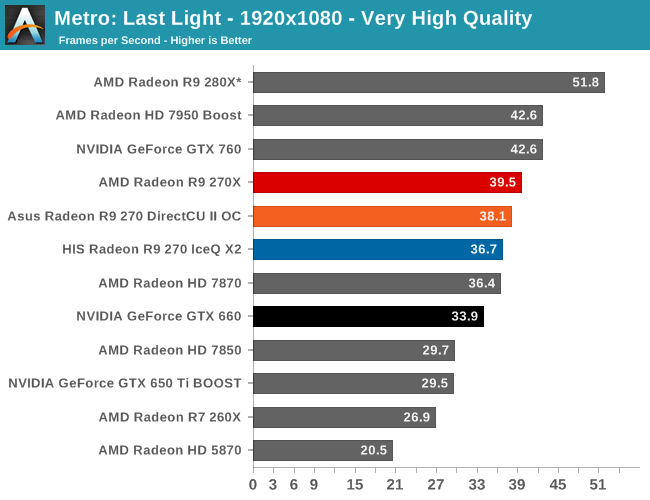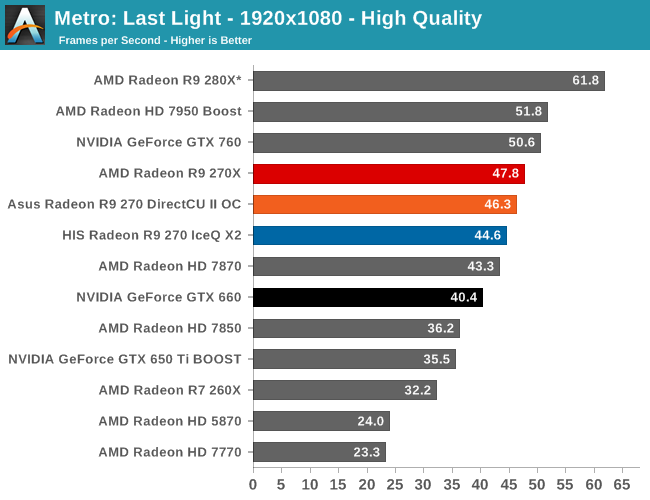The AMD Radeon R9 270X & R9 270 Review: Feat. Asus & HIS
by Ryan Smith on November 13, 2013 12:01 AM ESTMetro: Last Light
As always, kicking off our look at performance is 4A Games’ latest entry in their Metro series of subterranean shooters, Metro: Last Light. The original Metro: 2033 was a graphically punishing game for its time and Metro: Last Light is in its own right too. On the other hand it scales well with resolution and quality settings, so it’s still playable on lower end hardware.


AMD likes to pitch the 270 series as their primary 1080p cards, and although they generally do a perfectly fine job at it, Metro is a reminder that there are scenarios where they will come up short, particularly if trying to do 1080p at the highest quality settings. For these cards if we want framerates better than the 30s, we have to look at moving down a quality level.
At 1080p high quality, we can get our 270 cards up to the mid-40fps range. 270X of course leads the pack, but the 270 cards are very close behind owing to the fact that the only difference between the cards is the GPU clockspeed.
For the 270X in particular we’re looking at performance just a few frames per second behind the more expensive GTX 760, for a deficit of 6%. Otherwise the only cards close to it are of course the 270, and the outgoing 7870.
As for our 270 cards, they are second only to the 270X in anything near their price. The Asus card with its factory overclock is as to be expected faster, essentially splitting the difference between the stock clocked HIS 270 and the 270X. Furthermore in this test both cards are faster than the 7870 – a Pitcairn card with higher clockspeeds – showing the potency of the memory clockspeed increase. Finally, both cards are 10%+ faster than the GTX 660, making this an easy win for AMD.










59 Comments
View All Comments
iTzSnypah - Wednesday, November 13, 2013 - link
I'm not sure I like the R9 270. It should have been a cut card ~18CU's. I mean you can edit the BIOS to let up to +50% power limit so the only differentiation of the 270 and 270X (power) can be side stepped rather easily.The only hope is the 270X is binned much much higher than the 270 (to the point where the 270's are dogs), else there really isn't that much reason to buy one.
Also I'm surprised that the ASUS R9 270 wasn't a single 8pin connector.
blanarahul - Wednesday, November 13, 2013 - link
A single 8-pin connector would essentially make it a 270X.Gnarr - Wednesday, November 13, 2013 - link
Are you really complaining that the card is not handicapped enough and that you can get a very powerful card for a low price? And you say that you don't like that you can get this card this cheap?P39Airacobra - Saturday, May 31, 2014 - link
WTH? Really? That is the dumbest thing I ever heard! That is like getting a million dollars and then saying you should have got less. What is wrong with you?I am glad the 270 is just the same as the 270X, I only paid $179 for it, And all I have to do is go into CCC and set my clock from 925mhz to 1050, And bam I got 270X , And with better power efficiency. However I leave it at 925mhz because it has more than enough power to max most games at stock. You can't get a better deal than this right now. Now if AMD can just get their drivers right and keep the artifact problem gone. So far 14.4 stable has no artifacts, But the new 14.6 beta has artifacts in games that require physx, (like Mafia 2) So I just keep 14.4 installed. It's sad that it has been over 2 years and AMD is still having artifact problems in their drivers. This has effected allot of 280/280X users. Some figure out that it is the drivers, And others just returned their cards, It's amazing how nobody wants to admit what the real problem is, It is like they want to worship and praise AMD instead of solving the artifact issue.
The Von Matrices - Wednesday, November 13, 2013 - link
The 270X seems like a pointless card to anyone willing to adjust clock speeds since it is the same GPU as its cheaper sibling, much like the 7970 GHz edition was to the 7970. I remember most 7970s (including mine) easily clocked to 7970 GHz edition speeds with little or no voltage increase. Is the 270 the same in regards to reaching the clock speed of the 270X?kyuu - Wednesday, November 13, 2013 - link
I'm guessing the difference will be binning. So while you might end up with a 270 that can clock up to (or beyond) a 270X, there's a chance you may not if you were unlucky and ended up with lower quality silicon.blanarahul - Wednesday, November 13, 2013 - link
The difference will be TDP. I think the 270 is already operating near it's power limit. But the 270X has a lot of headroom.yacoub35 - Wednesday, November 13, 2013 - link
The right choice would be to get a 7950 Boost for under $200 and skip the 270-series generation which is rebranded lower-level hardware.doggghouse - Wednesday, November 13, 2013 - link
Yeah, the 7950 Boost is a great bargain for now... until the supplies dry up. I managed to grab one for my nephew's new PC for $160 after rebate! It even came with the Never Settle Gold... going to be a great addition to his first PC :)garadante - Wednesday, November 13, 2013 - link
I'm not sure if I'm missing the section that points it out, but what does the asterisk behind the 280X in the graphs represent? Does it represent some sort of caveat or warning that we should be aware of?